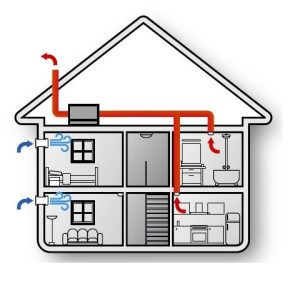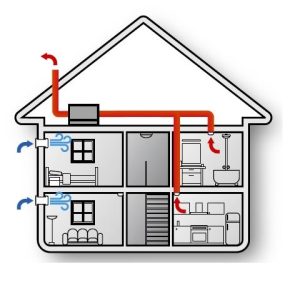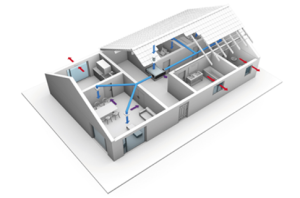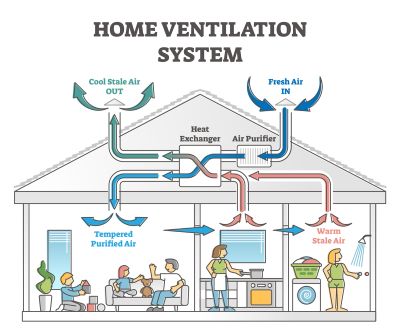In the residential ventilation sector, there is a growing need to provide specifiers, industry professionals, buyers and end users with verified performance data, for products and systems that deliver good Indoor Air Quality (IAQ), while also reducing the carbon footprint of homes. Developed alongside several European manufacturers, the Eurovent Certified Performance programme for Indoor Air Quality and Energy Efficiency (IAQVS) is designed to obtain a balance between energy performance and IAQ. In this article we discuss the programme background and certified characteristics, before exploring the ventilation systems in Europe that are covered by the certification, along with ventilation regulations. So read on to find out all you need to know about the IAQVS programme.
About the IAQVS programme
This programme is intended for ventilation systems in residential dwellings in individual housing, with an air flow rate < 1000m3/h. As mentioned, the primary aim of the programme is to obtain a balance between the energy performance of systems (e.g. heat loss induced by air renewal and consumption of the electric motor), and Indoor Air Quality (e.g. pollutants such as CO2 and formaldehyde, along with aspects such as humidity). With an international reach, the programme includes a range of systems such as:
- Single flow mechanical ventilation by extraction (self-regulating or humidity sensitive)
- Single flow mechanical ventilation by insufflation
- Centralised double flow mechanical ventilation with or without heat recovery
- Double flow mechanical ventilation, room by room.
The programme is aimed at manufacturers of both ventilation system components and entire systems.
Certified characteristics
The programme is based on the data from ventilation system components, which is then put into a state-of-the-art simulation tool. The characteristics of components and a system's performance can then be studied in all possible situations.

The characteristics of vents, air intakes, ducts and ventilation units can be certified or justified. Values justified by a test report from an ISO 17 025 accredited laboratory are penalised. As certified data has been independently validated for its accuracy via a vigorous certification process, no penalty is added to the calculations of certified products. The certification takes into account three different types of climates: moderate, hot and cold. The moderate climate is systematically tested. Simulations are carried out for at least 2 climates out of the 3.
The simulation models are carried out according to the area of use of the proposed ventilation system, and the number of main rooms and service rooms in the house. Each modelling iteration corresponds to the type of dwelling and field of use, by varying:
- Specific environment (wind profile, building orientation, etc.)
- Specific accommodation (e.g. an apartment with 1 living room and 2 bedrooms, of 79 m2 and 2.3 m high ceilings, with 1 separate bathroom and 1 toilet)
- Specific week of the year (e.g. week starting on the 24th day of the year = Sunday 24/01 to Saturday 30/01 inclusive)
- Scenario of specific activities (showering, cooking, laundry, etc.).
More than 2000 iterations are carried out during simulations, until the convergence of indoor air quality and energy performance indicators. The system provides a rating scale for individual IAQ scores, ranging from 0 to 5, with 5 being the highest rating achievable. An average IAQ score is also offered. The IAQVS Eurovent certification therefore allows a comparison between systems for the same type of housing.
European ventilation systems covered by the IAQVS certification
There are several types of ventilation systems on the European market, which are described in particular in the EN 12792 standard "Ventilation of buildings - Symbols, terminology and graphic symbols." These systems can apply for the IAQVS certification programme and are explored below.
Note: The following definitions are partly taken from the website of the French Association of Ventilation. For more information see the Overview of the different ventilation systems in a building (afventilation.org).
Mechanical ventilation by extraction

Auto Adjustable
It ensures constant air renewal, regardless of external conditions (wind, temperature) and indoor conditions (number of occupants, temperature, humidity, etc.). This system puts the building in a slight depression.
Humidity control

It varies the air renewal according to the indoor humidity, speeding up the evacuation of humid air (high occupancy, use of the kitchen, shower, etc.) and allows the ventilation to be adapted to real needs. When the air is drier, ventilation is reduced, thus optimizing the building's energy needs, and lowering the product's power consumption. The regulation is done mechanically by polyamide strips that lengthen when the humidity increases and shorten when the air dries out. This system puts the building in a slight depression.
- Type A: it is said to be hygro-controlled type A when only the exhaust vents are humidity-controlled.
- Type B: it is said to be hygro-controlled type B when the air inlets and exhaust vents are humidity-adjustable.
Mechanical ventilation by insufflation

This single-flow mechanical ventilation system blows fresh air through air vents at one or more points depending on the configuration of the installation. This system puts the building under slight overpressure. The air is exhausted through air outlets located in rooms with specific pollution. Some systems allow flow rate modulation.
There are different installation variants:
- Mechanical ventilation by centralised insufflation (one or two insufflation points).
- Mechanical ventilation by distributed insufflation (diagram)*.
*Not included in the simulation tool.
Dual Flow Mechanical Ventilation

Centralised
The centralised double-flow CMV uses two aeraulic networks and two fans. On the one hand, fresh air from the outside is brought into the living rooms via the insufflation network. On the other hand, the "stale" air is extracted at the level of the rooms with specific pollution or service rooms. At the intersection of the two networks, a heat exchanger recovers the heat or coolness of the air extracted from the house, in order to heat or cool the fresh filtered air coming from outside, thus optimising energy consumption. Some systems allow flow rate modulation.
Piece by piece
Compact dual-flow ventilation solution, allowing different rooms in the house to be treated individually. Integrated into the wall to ensure the ventilation of the room and equipped with an exchanger, it allows air renewal and heat recovery to breathe in new, pre-heated and filtered air and extract stale air.
Regulations in the field of ventilation
European Union
The European EPBD (Energy Performance of Buildings Directive - EU/2010/31), whose main objective is to increase the pace of building renovations in Europe, also contributes to improving air quality. The Commission has drawn up a set of standards and accompanying technical reports in support of the Directive. The EN 16798 series of standards explain how to apply the directive for ventilation aspects.
Given the differences between countries, the directive allows governments to adapt renovation measures to the national context. This means that ventilation regulations vary from country to country, so systems that comply with regulations in one country, may not comply in another. Each "national" Annex A will describe for each country how the standard is implemented.
The IQAVS programme therefore certifies energy performance and IAQ characteristics, not regulatory compliance. It is up to those specifying products to ensure that the application of the desired product is legal in their region.
While a lack of aligned regulation can cause complications, it does not mean that the IAQVS certification programme will stand still. Just like other Eurovent certified programmes, it will evolve in order to take into account normative and regulatory changes at European level and also market expectations. For example, a review is already underway to introduce an indicator for fine particulate matter. This will ensure the certification remains relevant and valuable for all industry stakeholders in Europe and beyond.
Conclusion
It is clear that times are changing, and that energy efficiency and indoor air quality are inextricably linked in our bid to decarbonise homes. A solution was therefore required to identify and rate IAQ and energy efficiency in residential ventilation applications.
For prescribers, industry professionals, buyers and end users, the IAQ indicators combined with the energy efficiency indicators displayed in the certification, help make informed choices. Those specifying, designing, buying, installing, or using products certified under IAQVS can be sure products have undergone thousands of simulations and be confident in verified product data.
If you want to find out more about the IAQVS programme please contact Sébastien Raffier or find out more on our IAQVS programme page. You can also search for certified products via our free certified product directory.


